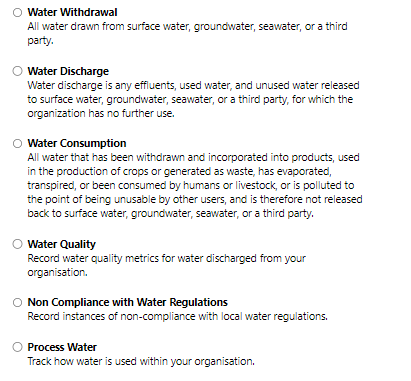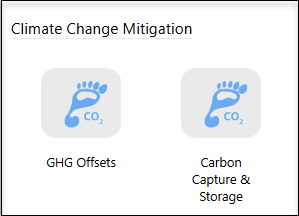Scopes, activities, and emission factors covered by Diligent ESG
The Diligent ESG Carbon and Sustainability Platform are continually being enhanced to increase its coverage. All of Scope 1, 2 and 3 greenhouse gas emissions are covered by the software in line with the Corporate Carbon Footprint requirements.
These are defined in the GHG Protocol Corporate Standard and are described below with their equivalent term from ISO 14064-1 in brackets:
-
Scope 1 - Direct Emissions: Emissions from activities owned or controlled by your organization that release emissions into the atmosphere. They are direct emissions. Examples of scope 1 emissions include emissions from combustion in owned or controlled boilers, furnaces, vehicles; emissions from chemical production in owned or controlled process equipment.

-
Scope 2 - Indirect Energy Emissions: Emissions released into the atmosphere associated with your consumption of purchased electricity, heat, steam and cooling. These are indirect emissions that are a consequence of your organization’s activities, but which occur at sources you do not own or control.

-
Scope 3 - Indirect Emissions (upstream activities): Emissions that are a consequence of your actions, which occur at sources which you do not own or control and which are not classed as scope 2 emissions. Examples of scope 3 emissions are business travel by means not owned or controlled by your organization, waste disposal which is not owned or controlled, or purchased materials or fuels.

Note
There are two separate water modules to choose from. The original Water Module (located within the Add New Activity screen under the Scope 3 Water icon) collects emissions as standard for the following two activity types: 1. Water Supply and 2. Water Discharge (treatment) as per the DEFRA publications. The more recent Water Management Module (located within the Add New Activity screen under the Scope 3 Sustainability (CSR) Environmental icon) only collects water quantity data. The available Activity Type options within this Water Management module are available as per image below. The Water Management module was created to assist in the further demands of water reporting required by reporting frameworks for which water sources are required to be recorded in more detail. If required, you can also calculate these emissions using DEFRA emission factors.

-
Biogenic emissions: Because of their biogenic origin, CO2 emissions from biomass fuels are treated differently from fossil fuel combustion emissions. The GHG Protocol Corporate Reporting Standard requires that CO2 emissions from biomass combustion be reported separately from the other scopes. Unlike CO2 emissions however, the combustion of biomass does in all cases result in net additions of CH4 and N2O to the atmosphere, and therefore emissions of these two greenhouse gases because of biomass combustion should be accounted for in emission inventories under Scope 1. When calculating the emissions from a biofuel blend, the CO2 emissions from the biofuel portion of the blend are reported separately under Biomass. All other emissions are reported under Scope 1. For further information about Biomass, go to Biomass in the Scope Selector.
-
Outside of scopes: The system currently only accounts for the Greenhouse Gases under the Kyoto Protocol. Refrigerants, which are Scope 1 Fugitive Emissions, often have blends. The gas blends that fall outside of the Kyoto Protocol gases must be classified separately as outside of scopes, while they are included in the company’s overall emissions. The GHG Protocol allows for reporting of these fugitive blends, but as separate memo items on an organization’s GHG inventory. For further information about outside of scopes gases, go to Methodological issues relating to fluorinated gases.
-
Well to Tank: Account for emissions associated with extracting, refining, and transportation of the raw fuel to the vehicle, asset or process under scrutiny. For further information about Well to Tank emissions and where to find them, go to Scope 3 Category 3 Fuel and energy-related activities.
-
Scope 3 - Indirect Emissions (downstream activities): Indirect emissions result from your company’s operations but originate from sources owned or controlled by other entities. Downstream emissions specifically relate to products sold by the company and occur after the point of sale, when the products are under another party’s control. For example, a customer.

-
Climate Change Mitigation: Climate change mitigation refers to actions that reduce or prevent the release of greenhouse gases (GHGs) to slow global warming. Common strategies include improving energy efficiency, switching to renewable energy sources, conserving forests, modifying agricultural practices, and reducing waste. Policy tools such as carbon taxes, regulations, and financial incentives can also help reduce emissions.
There are two primary climate change mitigation activities:
-
GHG Offsets
-
Carbon Capture and Storage
Both of these activities have a similar effect on the total GHG emissions.

-
-
Energy Production: This category tracks energy generated from various sources like biofuel, biogas, biomass, fossil fuels, hydro, landfill gas, natural gas, solar, waste, and wind. When energy is produced on-site and not connected to the grid, Scope 2 emissions are not reported because emissions from power generation are already included in Scope 1. For instance, electricity from a Combined Heat and Power (CHP) plant or Generator. The natural gas used would be recorded in the Stationary Combustion (Scope 1) category, with a meter to log the gas usage. Then, another meter is created to log the electricity produced.

- Sustainability (CSR): Sustainability metrics are indicators used to measure an organization’s performance in sustainability. These metrics support internal benchmarking, target setting, and year-over-year progress tracking.

In addition, Sustainability Metrics are available under the sections, Social Economic and Non-GHG Environmental.
Scope 3 Category 3 Fuel and energy-related activities
Under Scope 3 Category 3 in the Greenhouse Gas (GHG) Protocol, the Fuel and energy-related activities, not Included in Scope 1 or Scope 2, considers the Well-To-Tank (WTT) and Transmission & Distribution (T&D) losses of Scope 1 and Scope 2 categories.
These Scope 3 emissions are calculated by default when Scope 1 Mobile Combustion, Stationary Combustion, and Scope 2 Purchased Electricity emissions are entered within the system. These emissions include the extraction, production, and transportation of fuels used and also the emissions due to energy lost from transmission and distribution pipelines.
These Scope 3 Fuel and energy-related activities emissions are calculated as outlined in the GHG Protocol. For information, go tohttps://ghgprotocol.org/sites/default/files/standards_supporting/Chapter3.pdf.
Biomass in the Scope Selector
Biomass
Emissions that account for the direct CO2 impact of burning biomass and biofuels. Full reporting of any fuel from a biogenic source should have the Biomass CO2 value documented to ensure complete accounting for the emissions created. Biomass can be turned on/off through the selector on the left of the main screens under Scopes.
Biomass example:
To fully account for the biofuel content in diesel (average biofuel blend) and petrol (average biofuel blend), which both contain a percentage of biofuel blended with the standard mineral oil fuel, organisations must report both the emissions from the combustion of the fuel (scope 1) and the biogenic portion of the fuel (outside of scopes) i.e. in neither scope 1, 2 or 3.
-
All fuels with biogenic content should have the biogenic emissions reported to ensure a complete picture of an organisations’ emissions is created
-
All biogenic emissions factors are provided on a net CV basis
Emissions factors
A core aspect when calculating the GHG emissions of any activity is the emissions factor that you use in the calculation. Emissions factors are scientifically proven and approved numbers. The GHG emissions from an emissions source, for example kerosene, is calculated using the appropriate factor based on the consumed quantity of the emissions source. Diligent ESG follows the international best practice by selecting the most accurate emissions factors for each emissions source, based on the geographical location of where the emissions activity took place.
For more information about mapping emission factors, go to Mapping emission factors to waste fractions
For more information about what factors are applied to your data entries, go to Viewing emission factors applied to data entries.
For more information about Diligent ESG emissions factor methodologies and policies, contact the Support team.